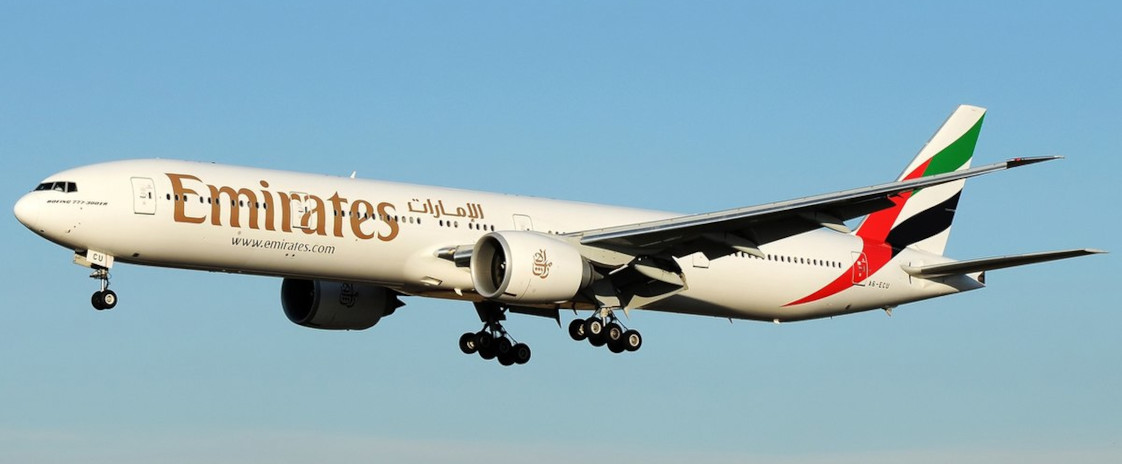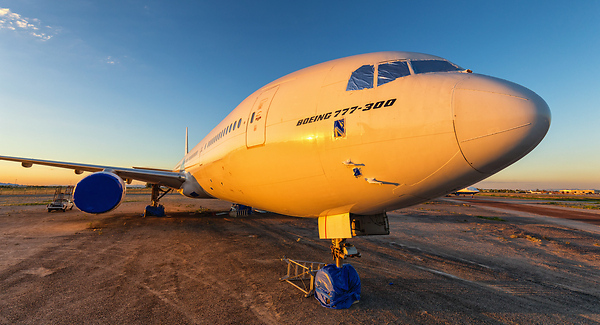
Boeing 777-300 Overview
The Boeing 777-300, a magnificent member of the Boeing 777 family of airplanes, has a number of unique features that make it a sought-after aircraft in the world of long-haul air travel. Let’s dive into the world of this leader of the skies and take a look at what makes it so special.
1- Impressive Dimensions:
One of the key features of the Boeing 777-300 is its impressive size. With a maximum takeoff weight of an impressive 775,000 pounds and a fuselage length of over 242 feet (approximately 74 meters), this giant of the skies is one of the largest in the world.
2- Maximum Capacity:
The Boeing 777-300 is designed to provide maximum passenger capacity. The medium passenger variant seats 386 to 550 people in a three-class layout, making it ideal for mass international transportation.
3- Advanced Engines:
This airplane is equipped with powerful engines for efficiency and range. Typically, the Boeing 777-300 utilizes General Electric GE90 engines that provide outstanding thrust and fuel economy.
4- Operational Efficiency:
The Boeing 777-300 is renowned for its operational efficiency. Its design and technology are aimed at reducing operating costs, making it attractive to airlines looking to optimize their fleets.
5- Ideal for Long-Routes:
This aircraft is the ideal choice for long-haul routes, providing passengers with a high level of comfort and airlines with savings. Its application provides fast and efficient travel between continents, making it an indispensable leader in its class.
6- Advanced Avionic Solutions:
The Boeing 777-300 is equipped with advanced avionic systems to ensure safety and reliability of flights at a high level. The control and navigation systems of this airplane meet the latest industry standards.
Boeing 777 200 Development
The history of the Boeing 777-300 dates back to the late 1980s when Boeing began research into a new, advanced long-range airplane. The main goal was to create an airliner that would combine outstanding capacity and range with advanced technology.
1990s: Development Phase:
In 1990, Boeing officially announced the Boeing 777 program, and the B777-300 was one of the variants of this family. The development phase focused not only on increasing size, but also on introducing new technologies such as efficient engines and advanced avionics systems.
1998-2003: Commissioning:
The first flight of the Boeing 777-300 took place in 1997, and the airplane first entered commercial service in 1998. In the years that followed, the airliner gained the trust of airlines for its reliability, fuel efficiency and outstanding performance.
2010s: Modernization and Improvement:
Throughout the 2010s, Boeing continued to introduce improvements to the Boeing 777-300, including new versions with more efficient engines, improved avionics and comfortable interiors. Modifications also aimed to increase fuel efficiency and reduce environmental impact.

Our Days: Prospects and Highs:
Currently, the Boeing 777 300 remains the undisputed leader in the long-haul airline segment. With continuous development, innovation and meeting changing market needs, this airliner continues to amaze the world with its reliability, efficiency and state-of-the-art technology.
777 300 Technical Details
Dimensions
| Length | 73.9 m |
| Wingspan | 60.9 m |
| Height | 18.5 m |
| Wing area | 427.8 sq. metres |

Flight data
| Range with max. load | 7 500 — 11 000 km |
| Max. cruising speed | 905 km/h |
| Maximum speed | 945 km/h |
| Ceiling (max. flight height) | 13 100 m |
| Run-up length | 3 700 m |
| Run length | 1 800 m |
| Engines | P&W PW4090, 2 x 40900 kgf P&W PW4098, 2 x 44500 kgf R-R Trent 892, 2 x 40900 kgf |
Passenger compartment
| Number of seats (economy) | 550 |
| Number of seats (economy/business) | 479 |
| Number of seats (economy/business/first) | 368 |
| Cabin width | 5.87 m |
Weight
| Max. take-off weight | 263 080 — 299 370 kg |
| Max. landing weight | 237 680 kg |
| Empty weight | 155 500 — 158 480 kg |
| Max. weight without fuel | 224 530 kg |
| Max. commercial load | 66 050 kg |
| Fuel tank capacity | 171 170 litres |
Boeing 777-300 Seat Map
First class is located in the forward part of the airplane and seats 8 passengers. The seats are arranged in a 1x2x1 layout on the 777-300 seat map. It is better to choose the middle seats for tourists traveling in a company, and single passengers are ideally suited to the seats near the portholes.
Business class is located right after the first one. The number of seats is 50, in a 2×2x2x2 layout. They also fold out into a full bed.
Economy class cabin in the standard 777-300 seat map accommodates about 230 people. The seats are usually arranged according to the principle: 9 seats or 10 seats in a row (3×3×3 or 3×4×3).
The best seats
Row 1, first class seats are quite comfortable. In this part of the cabin is quiet, the seats are wide, comfortable, soft and very much space between them. In addition, there is an opportunity to attach a cradle.
Seats in the Boeing 777-300 business class are located in the 11th and 12th rows. The distance between the seats is slightly reduced; nevertheless, the Boeing 777-300 seat map with a 2x2x2 layout is not bad. The minus of row 11 is that there is a toilet next to it, which can interfere with your peace of mind during the flight. However, there are cradle mounts provided in these seats.
Row 31 is the first row of economy class, here there are no neighbors in front, so the seats will not be reclined on you, and you can straighten your legs as you wish. The main disadvantage of the 777-300 seating by the porthole is the cold. Seats D, E, G have cradle mounts.
Good seats
Boeing 777-300 has seats, which can be found both advantages and disadvantages. Row 17, window seats. The usual bi-class seats. The main disadvantage is that there is no porthole or it is displaced in such a way that the passenger cannot comfortably watch the passing clouds.
Rows 32-37 are usual economy class 777-300 seating. The only inconvenience is that the wing covers the view.
Row 46 — is convenient for passengers with children, as there is an opportunity to attach a cradle. However, there are restrooms nearby, which can cause discomfort.
Each seat has pros and cons, but the most all have the most cons: In Row 42, seats C and H, passengers often complain about their seats being bumped by flight attendants with shopping carts or other airline customers walking down the aisle due to the Boeing 777-300 seat map. Some may even lean on the backs of their seats while waiting for their turn to use the restroom.
Rows 43, 44, 57 — they are located in front of the buffet and restroom, the walls of these rooms will prevent you from reclining the backrests completely. In addition, the outermost seats — D and G — can be hit by flight attendants’ carts and passengers.
Comparison of Boeing 777 300 Seat Maps
| Airline | Classes / Configuration | Total Seats |
| Air New Zealand Boeing 777-300 | Business Class / 1-2-1 Economy Premium / 2-4-2 Economy / 3-4-3 |
342 |
| Singapore Airlines Boeing 777-300 | First / 1-2-1 Business Class / 2-2-2 Economy / 3-3-3 |
284 |
| Thai Airways Boeing 777-300 | Business Class / 2-3-2 Economy / 3-3-3 |
364 |
| Japan Airlines Boeing 777-300 | Business Class / 2-3-2 Economy / 3-3-3 |
500 |
| Korean Air Boeing 777-300 | First / 2-2-2 Business Class / 2-3-2 Economy / 3-3-3 |
338 |
| British Airways Boeing 777-300 | First / 1-2-1 Business Class / 2-2-2 Economy Premium / 2-4-2 Economy / 3-3-3 |
299 |
| Cathay Pacific Boeing 777-300 v1 | First / 1-1-1 Business Class / 1-2-1 Economy Premium / 2-4-2 Economy / 3-3-3 |
275 |
| Cathay Pacific Boeing 777-300 v2 | Business Class / 1-2-1 Economy Premium / 2-4-2 Economy / 3-4-3 |
368 |
| Cathay Pacific Boeing 777-300 v3 | First / 1-1-1 Business Class / 1-2-1 Economy Premium / 2-4-2 Economy / 3-4-3 |
294 |
| Cathay Pacific Boeing 777-300 v4 | Business Class / 2-3-2 Economy / 3-4-3 |
438 |


